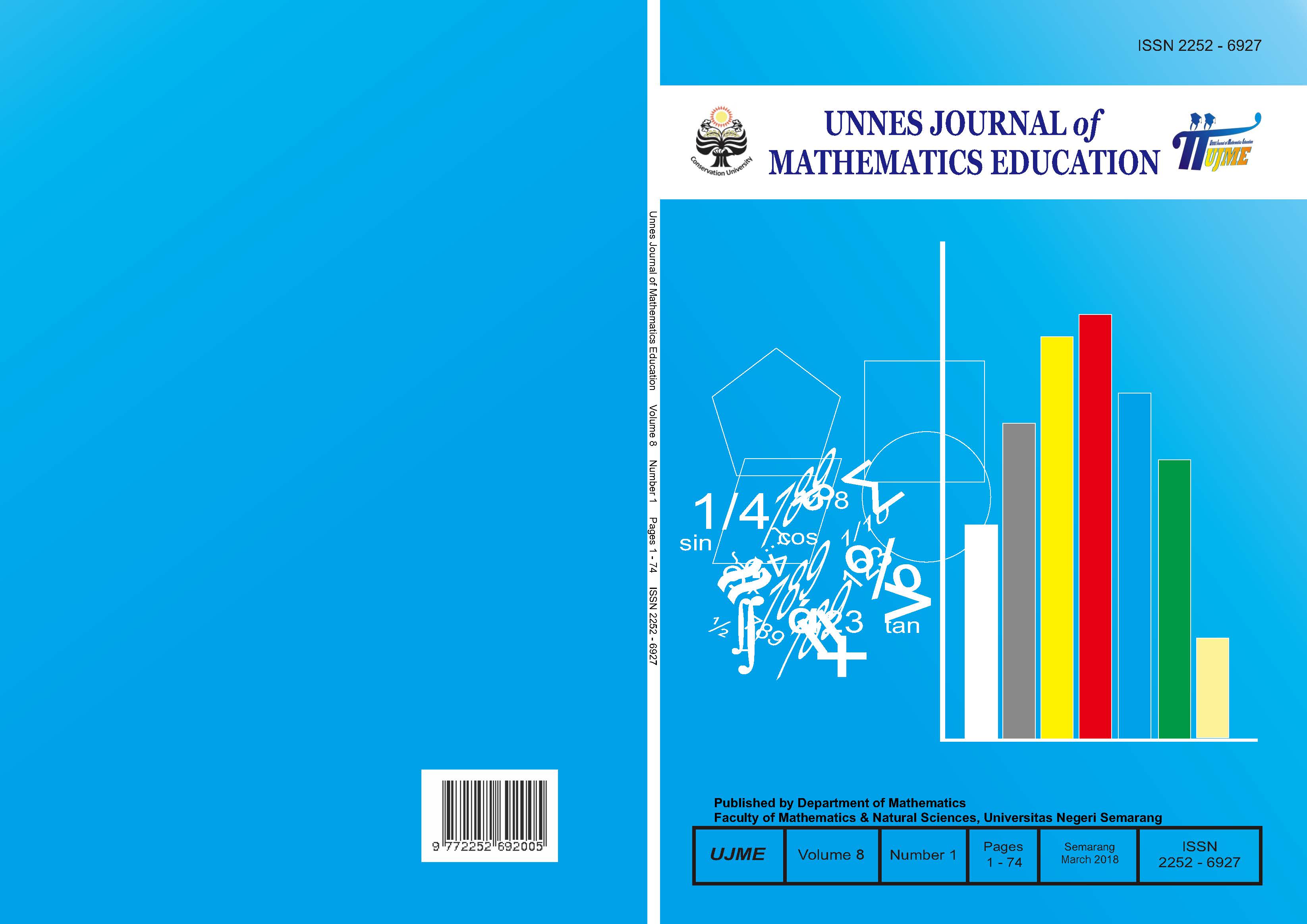The creative thinking ability in anchored instructions (AI) learning reviewed from mathematical disposition
##plugins.themes.academic_pro.article.main##
Abstract
The purposes of this research were to test the learning process using Anchored Instructions (AI) model to reach the learning mastery and to describe the ability of creative thinking use Anchored Instructions (AI) reviewed from Mathematical disposition. This research was mix methods research with triangulation concurrent model. The population in this research was VII grade students of SMP N 3 Ungaran academic year 2017/2018. The sample was the students of VII-I class. Particularly, the subject of this research was the students of VII-I class who have high, medium, and low mathematical disposition category. This research used quantitative data to test the average of one group and the proportion of the other group. Further, the qualitative data were analyzed by Miles and Huberman model. In the process of the interview, there were two subjects in each mathematical disposition category. Eventually, the result of this research showed that the learning process by using Anchored Instructions (AI) model reached the learning mastery and described the ability of students' creative thinking with Anchored Instructions (AI) model reviewed from mathematical disposition. It was proven through the students with high mathematical disposition who had all of the aspects of mathematical disposition ability namely fluency, flexibility, and novelty. The students with medium mathematical disposition had fluency and flexibility aspect of mathematical disposition ability. The last, the students with low mathematical disposition only had one aspect of creative thinking ability that was fluency.
##plugins.themes.academic_pro.article.details##
References
Choridah, D. T. 2013. Peran Pembelajaran Berbasis Masalah untuk Meningkatkan Kemampuan Komunikasi dan Berpikir Kreatif serta Disposisi Matematis Siswa SMA, Jurnal Ilmiah Program Studi Matematika STKIP Siliwangi Bandung, Vol 2, No. 2, September 2013. Tersedia di http://e-journal.stkipsiliwangi.ac.id/index.php/infinity/article/view/35 [diakses 22-01-2018].
Creswell, J. W. 2014. Research Design Pendekatan Kualitatif, Kuantitatif, dan Mixed. Yogyakarta: Pustaka Belajar.
Depdiknas. 2006. Peraturan Menteri Pendidikan Nasional Republik Indonesia (Permendikbudnas) Nomor 23 Tahun 2006 Tentang Standar Kompetensi Lulusan Sekolah Menengah Pertama. Jakarta: Depdiknas.
Hafizah, E. 2014. Pengaruh Model Pembelajaran Anchored Instruction terhadap Penguasaan Konsep dan Kemampuan Pemecahan Masalah Fisika Kelas X. Jurnal Fisika Indonesia, Vol. 18, No. 52, April 2014, 8-12. Tersedia di https://www.neliti.com/id/publications/79849/pengaruh-model-pembelajaran-anchored-instruction-terhadap-penguasaan-konsep-dan [diakses 22-10-2015].
Hidayah, N., et. al. 2017. Kemampuan Berpikir Kreatif Matematis Siswa melalui Model Creative Problem Solving Ditinjau dari Kecerdasan Logis matematis Siswa, Unnes Journal of Mathematics Education.
Kaltz, L.G. 1993. Dispotition as Education Goal. Tersedia di https://files.eric.ed.gov/fulltext/ED363454.pdf [diakses 01-10-2018].
Mahmudi, A. 2010. Mengukur Kemampuan Berpikir Kreatif Matematis. Makalah disajikan pada Konferensi Nasional Matematika XV UNIMA. Manado: Jurusan Pendidikan Matematika UNY. Tersedia di http://staff.uny.ac.id/sites/default/files/penelitian/Ali%20Mahmudi,%20S.Pd,%20M.Pd,%20Dr./Makalah%2014%20ALI%20UNY%20Yogya%20for%20KNM%20UNIMA%20_Mengukur%20Kemampuan%20Berpikir%20Kreatif%20_.pdf [diakses 03-12-2015].
. 2010. Pengaruh Pembelajaran dengan Strategi MHM Berbasis Masalah terhadap Kemampuan Berpikir Kreatif, Kemampuan Pemecahan Masalah, dan Disposisi Matematis, serta Persepsi terhadap Kreativitas. Tesis. Bandung: Universitas Pendidikan Indonesia.
. 2010. Tinjauan Asosiasi antara Kemampuan Pemecahan Masalah Matematis dan Disposisi Matematis. Prosiding Seminar Nasional Pendidikan Matematika. Yogyakarta: Universitas Negeri Yogyakarta.
Munandar, U. 2012. Pengembangan Kreativitas Anak Berbakat. Jakarta: Rineka Cipta
Rifa’i, A. dan C.T. Anni. 2009. Psikologi Pendidikan. Semarang: Universitas Negeri Semarang Press.
. 2011. Psikologi Pendidikan. Semarang:UPT Unnes Press.
Siswono. 2004. Mendorong Berpikir Kreatif Siswa melalui Pengajuan Masalah (Problem Posing). Konferensi Nasional Matematika XII. Bali: Universitas Udayana.
. 2007. Penjenjangan Kemampuan Berpikir Kreatif dan Identifikasi Berpikir Kreatif Siswa Dalam Memecahkan dan Mengajukan Masalah Matematika. Disertasi. Tidak dipublikasikan. PPS UNESA Surabaya.
Sudiarta. 2007. Pengembangan Pembelajaran Berpendekatan Tematik Berorientasi Pemecahan Masalah Matematika Terbuka untuk Mengembangkan Kompetensi Berpikir Divergen, Kritis, dan Kreatif, Jurnal Pendidikan dan Kebudayaan, No. 069, November 2007. Tersedia di http://download.portalgaruda.org/article.php?article=465679&val=9630&title=PENGEMBANGAN%20PEMBELAJARAN%20BERPENDEKATAN%20TEMATIK%20BERORIENTASI%20PEMECAHAN%20MASSALAH%20MATEMATIKA%20TERBUKA%20UNTUK%20MENGEMBANGKAN%20KOMPETENSI%20BERPIKR%20DIVERGEN,%20KRITIS%20DAN%20KREATIF [diakses 23-09-2018].
Sudjana, N. 2005. Penelitian dan Penilaian Pendidikan. Bandung : Sinar Baru.
Sugilar, H. 2013. Meningkatkan Kemampuan Berpikir Kreatif Dan Disposisi Matematik Siswa Madrasah Tsanawiyah Melalui Pembelajaran Generatif, Jurnal Ilmiah Program Studi Matematika STKIP Siliwangi Bandung, Vol 2, No. 2, September 2013.
Sugiyono. 2015. Metode Penelitian Pendidikan Metode Penelitian Pendekatan Kuantitatif, Kualitatif, dan R&D. Bandung: Alfabeta.
Sumarmo, Utari. 2013. Kumpulan makalah berpikir dan disposisi matematik serta pembelajarannya. Bandung: Fakultas Pendidikan Matematika dan Ilmu Pengetahuan Alam Universitas Pendidikan Indonesia Bandung.
Syaban, M. 2009. Menumbuhkembangkan Daya dan Disposisi Matematis Siswa SMA melalui Model Pembelajaran Investigasi. Jurnal Educationist. Tersedia di http://file.upi.edu/-Direktori/JURNAL/EDUCATIONIST/Vol._III_No._2-Juli_2009/08_Mumun_Syaban.pdf [diakses 22-01-2018].
